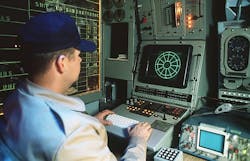Communications and Power to provide traveling wave tubes for Navy shipboard EW systems
CRANE, Ind., 21 July 2014. U.S. Navy electronic warfare (EW) experts needed traveling wave tubes (TWTs) to repair and refurbish the AN/SLQ-32 shipboard EW systems. The found their solution from Communications & Power Industries LLC in Palo Alto, Calif.
Officials of the Naval Surface Warfare Center Crane Division in Crane, Ind., announced an $18.8 million contract to Communications & Power on Friday to repair and remanufacture the SLQ-32's output, driver and sidekick output TWTs for ship repair and refurbishment.
The AN/SLQ-32 output, driver, and sidekick output TWTs are an integral part of the AN/SLQ-32 electronic countermeasures system and are used to amplify RF energy to defeat anti-ship missile systems.
A TWT is a specialized vacuum tube that amplifies microwave signals by absorbing power from a beam of electrons as it passes down the tube. It has a special ability to amplify a wide range of frequencies, and is used widely as the power amplifiers and oscillators in EW systems, as well as radar and transmitters for communication satellites and spacecraft.
Related: Communications & Power Industries wins $15 Million to support Aegis weapons system radar
The SLQ-32 is the Navy's standard shipboard EW system today, and provides early warning, identification, and tracking of enemy threats, as well as some simultaneous jamming of several different threats.
The TWT is an elongated vacuum tube with an electron gun at one end. A voltage applied across the cathode and anode accelerates the electrons towards the far end of the tube, and an external magnetic field around the tube focuses the electrons into a beam. At the other end of the tube the electrons strike a collector, which returns them to the circuit.
Wrapped around the inside of the tube, just outside the beam path, is a helix of wire, typically oxygen-free copper. The RF signal to be amplified is fed into the helix at a point near the emitter end of the tube. The signal is normally fed into the helix via a waveguide or electromagnetic coil placed at one end, forming a one-way signal path, a directional coupler.
The Navy's current Raytheon AN/SLQ-32 shipboard EW system was conceived in the early 1970s in part from lessons learned from an incident during the Six-Day War in 1967 when Egypt sank the Israeli destroyer Elath using a Soviet SS-N-2 STYX anti-ship missile.
The SLQ-32 began service as a simple threat warning receiver able to receive high-band radar signals of missiles and aircraft. Later the system was enhanced with the ability to receive signals from surveillance and targeting radars to provide passive targeting for anti-ship missiles.
Eventually the SLQ-32's version 3 system added active radar-jamming capability for cruisers, large amphibious ships, and high-value replenishment vessels. The SLQ-32's aircraft carrier version has separate systems for both sides of these large vessels.
Most versions of the SLQ-32 connect with the MK36 decoy launching system that uses chaff and infrared decoys to confuse the targeting radar of incoming anti-ship missiles.
A major program is in place called the Surface Electronic Warfare Improvement Program (SEWIP) to upgrade the AN/SLQ-32. The General Dynamics Corp. Advanced Information Systems segment in Fairfax, Va., is prime contractor for SEWIP block 1, while the Lockheed Martin Corp. Radar Systems segment in Liverpool, N.Y., is in charge of the SEWIP Block 2 system. A team of Raytheon and Lockheed Martin is the prime contractor on SEWIP block 3.
On this contract Communications & Power will do the work in Palo Alto, Calif., and should be finished by July 2019. For more information contact Communications & Power online at www.cpii.com.

